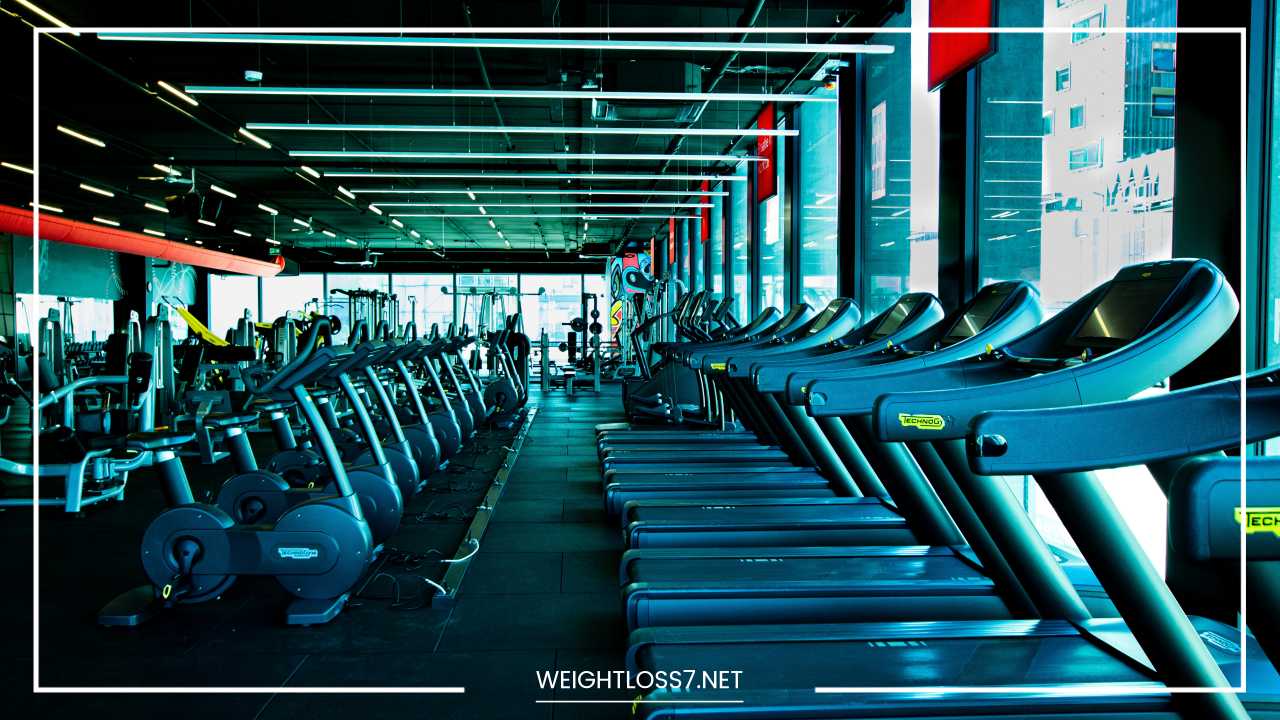The Ultimate Gym Guide: Beginner to Buff

Gym
The Ultimate Guide to Gyms: From Beginner to Buff
The gym. A place of iron dreams and sculpted physiques, but also a potential source of intimidation for the uninitiated.
Whether you’re a seasoned gym rat or someone nervously eyeing the dumbbells from afar, this comprehensive guide is here to equip you with the knowledge and confidence to navigate the world of gyms and achieve your fitness goals.
Deciphering the Gym Lingo: A Comprehensive Dictionary
Before diving headfirst into the weight room, let’s break down the common gym terminology you’ll encounter. Consider this your personal decoder ring for the fitness world:
- Cardio: These exercises elevate your heart rate and improve your cardiovascular health. Think treadmills, stationary bikes, elliptical trainers, and swimming.
- Strength Training: This involves using weights (free weights or machines) or resistance bands to build muscle mass and strength.
- Free Weights: Dumbbells, barbells, and weight plates offer a wider range of motion in exercises, allowing for greater customization and targeting specific muscle groups.
- Machine Weights: These are weight training equipment with predetermined paths of motion. They offer a safer and more guided workout, particularly for beginners.
- Reps (Repetitions): The number of times you complete a full exercise.
- Sets: A group of repetitions performed consecutively with a short rest period in between (e.g., 3 sets of 10 repetitions).
- Personal Trainer (PT): A certified professional who designs personalized workout plans, provides guidance during exercise sessions, and helps you stay motivated and accountable.
- Group Fitness Classes: Structured exercise classes led by an instructor, focusing on specific activities like yoga, Zumba, HIIT (High-Intensity Interval Training), spin, Pilates, or boot camp.
Finding Your Perfect Gym Match: Beyond Location and Price
Gyms are as diverse as the people who use them. Here are some key factors to consider when embarking on your gym odyssey:
Location, Location, Location (and More): Convenience is crucial. Ideally, choose a gym close to your home or workplace to minimize travel time and maximize workout consistency.
Facility Features: Does the gym offer the equipment you need to achieve your goals? This could include cardio machines, free weights, specific strength training equipment (e.g., squat racks, benches), functional training areas, and stretching zones. Consider if the gym offers amenities like locker rooms, showers, towels, and saunas – these can enhance your overall gym experience.
Ambiance Matters: Does the gym have a vibe that resonates with you? Is it loud and energetic, or calm and focused? Some gyms cater to a specific clientele, so look for one that feels welcoming and where you feel comfortable working out.
Budgeting for Fitness: Gym memberships vary significantly in price. Compare membership fees and packages to find one that fits your budget. Don’t be afraid to inquire about student discounts, senior rates, or introductory offers.
Trial Runs are Your Friend: Many gyms offer guest passes or trial memberships. Take advantage of these opportunities to try out the facilities, sample some group fitness classes, and get a feel for the atmosphere before committing.
Pro Tip: Don’t be shy! Ask the staff questions about their facilities, class schedules, membership options, and personal training services.
Conquering Your First Gym Visit: A Beginner’s Roadmap
Feeling a rush of pre-gym jitters? It’s completely normal! Here are some tips to navigate your first foray into the gym with confidence:
- Set SMART Goals: Don’t overwhelm yourself by aiming for a beach body in a week. Start with Specific, Measurable, Achievable, Relevant, and Time-Bound goals. Focus on building healthy habits and consistency rather than immediate results.
- Dress for Success: Wear comfortable clothing that allows for a full range of motion and breathability. Opt for moisture-wicking fabrics to stay cool and dry during your workout.
- Get Oriented: Ask a staff member for a tour of the gym. They can explain how the equipment works, answer any questions you might have, and point you in the right direction.
- Consider a Personal Trainer: Especially for beginners, a PT can be a valuable asset. They can create a tailored workout plan that aligns with your goals, ensure proper form to avoid injuries, and provide ongoing motivation and support.
- Don’t Be Afraid to Ask for Help: If you’re unsure how to use a piece of equipment, don’t hesitate to ask a staff member or a friendly gym-goer for guidance. Remember, everyone started somewhere!
Gym Etiquette 101: The Unspoken Rules of Respectful Coexistence
Gyms function smoothly thanks to a set of unspoken social norms. Here’s how to be a courteous gym-goer and ensure everyone has a positive experience:
- Wiping Down is Winning: After using any equipment, wipe it down with a disinfectant wipe to keep the gym clean and prevent the spread of germs. Most gyms provide wipes for this purpose.
- Re-Racking Rocks: Don’t be “that person” who leaves weights scattered around the gym floor. Put weights back on the rack where you found them so others can easily access them.
- Sharing is Caring: If the gym is busy and someone is using a piece of equipment you want, politely ask if they can share or how long they expect to be using it. Be prepared to offer an alternative exercise or wait your turn patiently.
- Mind Your Body Odor: Maintain good hygiene by showering before and after your workout, and wear deodorant to be considerate of others. Strong perfumes and colognes can also be bothersome in a confined space.
- Respect the Personal Space Bubble: Avoid hovering over people using equipment or lingering too close while they’re resting. Give everyone ample space to feel comfortable during their workout.
- Curb the Grunting: While a little exertion noise is understandable, excessive grunting or yelling can be disruptive to others. Focus on controlled breathing and maintain a respectful volume level.
- Cell Phone Etiquette: If you must use your phone, keep calls brief and avoid loud conversations. Texting or checking social media during rest periods is perfectly acceptable, but avoid hogging equipment while glued to your phone screen.
- Music to Your Ears (or Not): Keep headphone volume low so your music doesn’t disturb others. If you prefer a speaker, inquire about designated areas for using them.
- Etiquette Extends Beyond the Gym Floor: Be mindful of your behavior in locker rooms and common areas. Respect other people’s property and maintain a clean and orderly environment.
- Leave Your Ego at the Door: Gyms are for everyone, regardless of fitness level. Be encouraging and supportive of others, and celebrate everyone’s progress.
Building a Sustainable Workout Routine: Beyond the Basics
Now that you’re comfortable navigating the gym environment, it’s time to design a workout routine that aligns with your goals and keeps you motivated in the long run. Here are some key principles to consider:
- Warm-Up is Crucial: Before any workout, dedicate 5-10 minutes to light cardio (e.g., brisk walking, jumping jacks) and dynamic stretches to prepare your body for exercise and reduce the risk of injury.
- Embrace Variety: Don’t get stuck in a rut! Alternate between cardio, strength training, and core exercises to keep your workouts interesting and challenge different muscle groups. This also helps prevent plateaus in your fitness progress.
- Progressive Overload is Your Friend: To keep seeing results, gradually increase the weight, reps, or sets of your exercises as you get stronger. This challenges your muscles to adapt and keeps you progressing towards your goals.
- Listen to Your Body: Don’t push yourself to the point of exhaustion or pain. Take rest days to allow your muscles to recover and rebuild. If you experience any pain, stop the exercise and consult a doctor or physical therapist.
- Fuel Your Fitness: Nutrition plays a vital role in fitness success. Eat a balanced diet that provides your body with the energy it needs to power your workouts and support muscle recovery.
- Find Your Fitness Tribe: Working out with a friend or joining a group fitness class can boost motivation, accountability, and make exercise more enjoyable.
Sample Workout Routines:
To get you started, here are a few sample workout routines that you can adapt based on your fitness level and goals:
Beginner Full-Body Workout:
- Day 1: Cardio (30 minutes) + Lower Body Strength Training (3 sets of 10-12 reps per exercise) – Squats, lunges, calf raises
- Day 2: Rest
- Day 3: Upper Body Strength Training (3 sets of 10-12 reps per exercise) – Push-ups (modified if needed), rows, overhead press
- Day 4: Cardio (20 minutes) + Core Exercises (3 sets of 15-20 reps per exercise) – Plank variations, crunches, Russian twists
Intermediate Split Routine:
- Day 1: Chest & Triceps (4 sets of 8-12 reps per exercise)
- Day 2: Rest or Active Recovery (light cardio, yoga)
- Day 3: Back & Biceps (4 sets of 8-12 reps per exercise)
- Day 4: Cardio (30 minutes) & Core Blast (15 minutes)
- Day 5: Legs & Core (4 sets of 10-15 reps per exercise)
- Day 6: Rest
- Day 7: Cardio (HIIT or interval training for 20-30 minutes)
Advanced Push-Pull Legs Split:
- Day 1: Push (Chest, Shoulders, Triceps) (4 sets of 6-10 reps per exercise)
- Day 2: Pull (Back, Biceps) (4 sets of 6-10 reps per exercise)
- Day 3: Legs & Core (4 sets of 8-12 reps per exercise)
- Day 4: Rest
- Day 5: Active Recovery (light cardio, yoga, stretching)
- Day 6: Push (Heavier weights, lower reps) (3 sets of 4-6 reps per exercise)
- Day 7: Pull (Heavier weights, lower reps) (3 sets of 4-6 reps per exercise)
Remember: These are just samples, and you should adjust them based on your individual needs and goals. It’s always recommended to consult with a certified personal trainer for a personalized workout plan, especially if you have any injuries or specific fitness goals.
Beyond the Iron: Unveiling the Diverse Fitness Landscape
The gym isn’t the only path to fitness success. Here’s a glimpse into the broader world of exercise options:
- Outdoor Activities: Embrace nature with activities like hiking, biking, swimming, or jogging. Team sports like soccer or basketball can also provide a fun and social workout experience.
- Home Workouts: No gym membership? No problem! Plenty of bodyweight exercises and online workout programs can keep you fit from the comfort of your home.
- Mind-Body Practices: Yoga, Pilates, and Tai Chi combine physical movement with mindfulness and breathwork, promoting relaxation and stress reduction alongside physical benefits.
- Dance Fitness: From Zumba to salsa, dance fitness classes offer a fun and energetic way to get your heart rate up and burn calories while learning new moves.
Staying Motivated: Conquering the Plateau and Sticking with It
Motivation can ebb and flow. Here are some tips to stay on track and avoid giving up:
- Set Realistic Goals: Celebrate small victories along the way, and don’t get discouraged by setbacks. Focus on progress, not perfection.
- Find a Workout Buddy: Having a partner to hold you accountable and make workouts more enjoyable can be a game-changer.
- Track Your Progress: Keep a workout log or use a fitness app to monitor your progress. Seeing how far you’ve come can be a powerful motivator.
- Reward Yourself: Celebrate milestones with non-food rewards like a new workout outfit or a relaxing massage.
- Mix Things Up: Keep your workouts interesting by trying new exercises, classes, or activities.
- Listen to Your Body: Don’t be afraid to take rest days or modify workouts when needed. Overtraining can lead to burnout and injuries.
- Focus on How You Feel: Shift your mindset from aesthetics to how exercise makes you feel – energized, confident, and strong.
Remember, fitness is a journey, not a destination. Embrace the process, celebrate your progress, and enjoy the journey to a healthier and happier you!

















